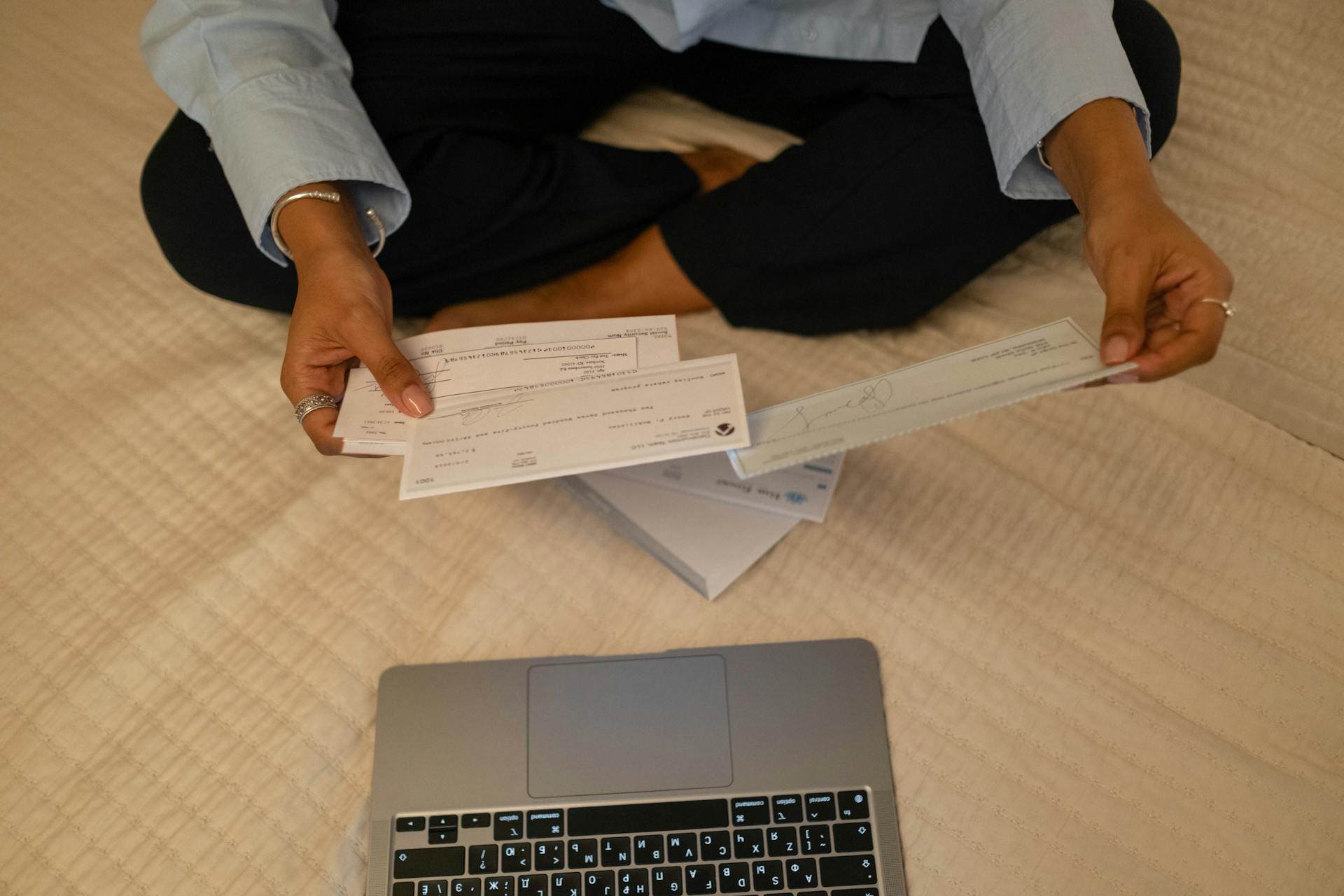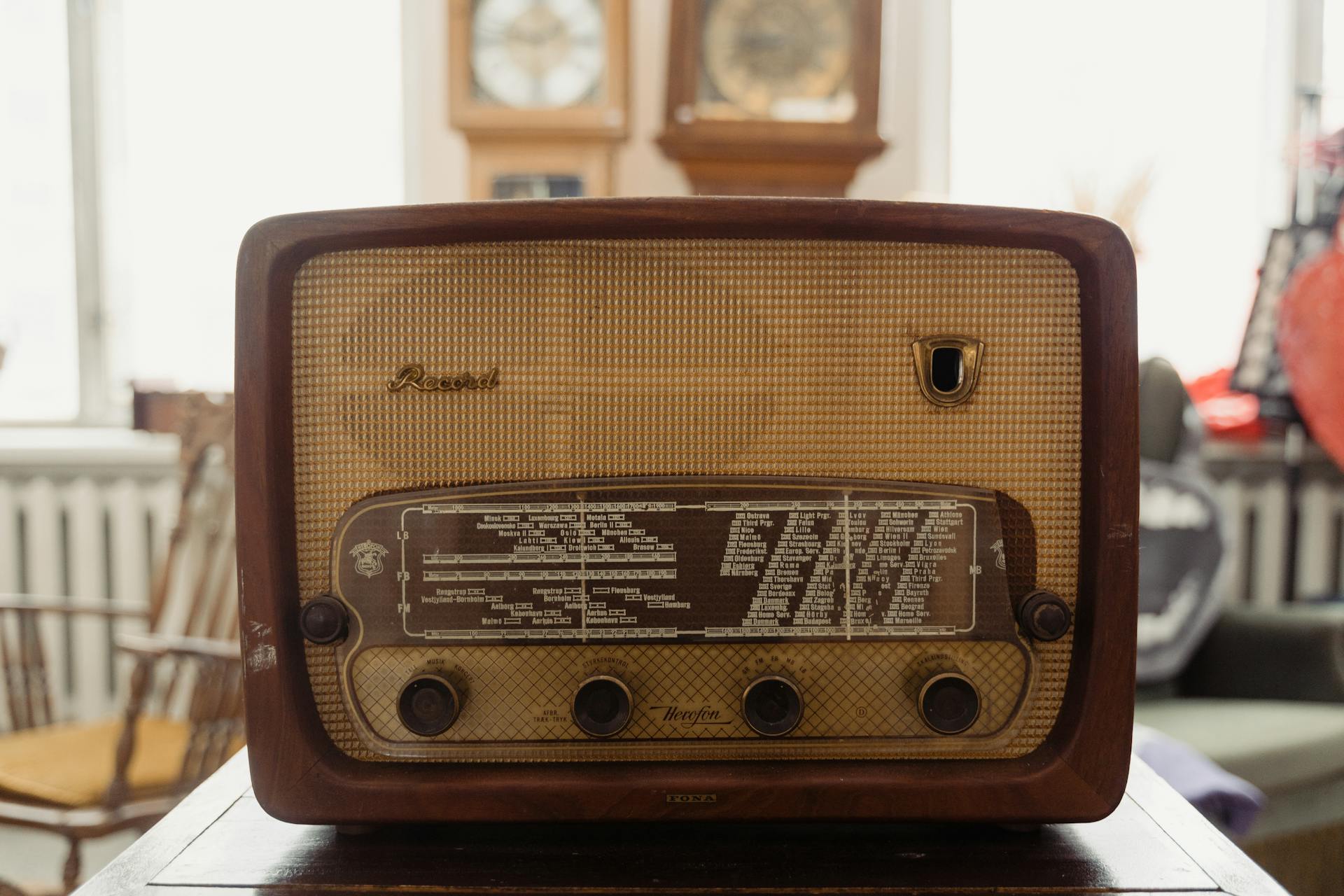
A bearer cheque is a type of cheque that can be cashed by anyone who presents it, as long as they have it in their possession.
To get a bearer cheque, you typically need to visit a bank in person and provide valid identification.
Bearer cheques are not as widely used as they once were, due to the risk of fraud and theft.
They can be used for both personal and business transactions, but are often used for smaller amounts.
What Is a
A bearer cheque is a type of cheque that allows the person holding it to receive payment without needing identification or endorsement. This makes it a quick and easy way to make transactions.
One of the main characteristics of a bearer cheque is that it can be used to obtain funds from a bank without much hassle. This is because it doesn't require the account holder's authorisation to get the payment.
Related reading: Virtual Debit Card Free without Verification Usa
You can transfer a bearer cheque through simple delivery, and the bank will pay you if you bring the cheque to the bank. This is a convenient feature that makes bearer cheques ideal for making immediate payments or paying off debts.
However, there are some risks associated with bearer cheques, such as the possibility of the cheque getting stolen. If this happens, you will lose the amount stated on the cheque.
To avoid any potential issues, it's essential to ensure that the cheque is properly filled out and doesn't leave any space between the words, rupees, or pay column. This will prevent fraudsters from committing fraud.
You might like: Outstanding Cheques in Bank Reconciliation
Writing and Withdrawal
Writing a bearer cheque is a straightforward process, but it's essential to follow the rules to avoid any issues. You'll need a blank cheque from your bank to get started.
To write the cheque, you'll need to write the current date on the top-right corner of the cheque. This is a crucial step, as it ensures the cheque is valid for the specified period.
The next step is to write "Bearer" or just "Cash" on the line beneath "Pay." This indicates that the cheque can be cashed by anyone who presents it, making it a bearer cheque.
You'll also need to write the amount you wish to pay in numerical form in the space provided next to the currency symbol. For example, if you're paying ₹10,000, you'll write "10000" in this space.
Below the numerical amount, write the same amount in words. Remember to end the sentence with the word "only" to prevent any tampering. For instance, you'd write "Ten thousand only" for the same amount.
If you want to include a remark or reference on the designated line, you can do so to indicate the reason for the payment.
To verify that the date, amount, and your signature are all correct on the cheque, take a moment to review it carefully before handing it along.
Here are the essential steps to writing a bearer cheque:
- Write the current date on the top-right corner of the cheque.
- Write "Bearer" or just "Cash" on the line beneath "Pay."
- Enter the amount you wish to pay in numerical form in the space provided next to the currency symbol.
- Write the same amount in words below the numerical amount, ending with the word "only."
- Sign the cheque in the space available, indicated by the words "authorised signatory."
Once you've written the cheque, you can hand it over to the bearer, who can then cash it at a bank. However, be aware that banks may have specific rules and procedures for cashing bearer cheques, so it's always a good idea to check with them beforehand.
Withdrawal Limits
Withdrawal limits on bearer cheques vary across banks and are influenced by factors such as account type, client relationship, and bank policy. It's essential to contact your bank directly to determine the specific withdrawal limit that applies to bearer cheques.
Some banks may restrict bearer cheque withdrawals to reduce the risks of large transactions. These restrictions can change depending on the bank's rules, the account holder's standing with the bank, or other elements.
Banks may impose withdrawal limits on bearer cheques, with specific limits varying across banks. The withdrawal limit for bearer cheques may differ based on the bank and the type of account you hold.
If you plan a significant withdrawal via bearer cheque, some banks may ask the account holder to provide advance notice. This is usually the case for large transactions.
To determine the precise withdrawal limit that applies to bearer cheques, it's best to contact your bank and ask about their specific laws and regulations.
Suggestion: Wells Fargo Debit Card Atm Limit
Encashing and Payment
You can encash a bearer cheque at any bank that accepts them, but it's a good idea to call the bank in advance to confirm their regulations and processes.
A bearer cheque can be cashed at any bank branch, and the payment amount will not be denied. The branch will forward a scanned copy of the cheque to the main branch for verification before the payment is authorized.
Bearer cheques offer instant payment, transferability, anonymity, flexibility, and convenience. They allow for swift transactions, eliminating the need for verification or endorsement.
You can encash a bearer cheque from any bank branch, as long as the bank accepts them. The branch will not deny the payment amount mentioned on the cheque.
Bearer cheques have a three-month validity period, after which they become stale and are no longer valid. Banks will not accept such cheques after this period.
Here are some key benefits of a bearer cheque:
- Instant payment
- Transferability
- Anonymity
- Flexibility
- Convenience
To convert a bearer cheque into an Order cheque, you simply need to draw a horizontal line across the words 'on bearer', which are stated on the top and right sides of the cheque.
Security and Verification
Banks may verify a bearer cheque's authenticity by scanning it or confirming it with the issuing branch to ensure legitimacy.
To prevent cheque fraud, banks take the verification process seriously, making it a crucial step in the cheque clearing process.
This verification process helps prevent counterfeit cheques from being cashed, giving you peace of mind when using bearer cheques.
Suggestion: American Express Travel Cheques
Verification of Authenticity
Verification of Authenticity is a crucial step in ensuring the legitimacy of financial transactions. Banks may verify a bearer cheque's authenticity by scanning it.
To confirm the legitimacy of a cheque, banks can contact the issuing branch directly. This process helps prevent fraud and ensures that the cheque is genuine.
Scanning a cheque can also reveal any tampering or alteration attempts. This helps to prevent unauthorized transactions and protects the account holder's funds.
Anonymity
Anonymity is a unique aspect of bearer cheques. They provide a degree of anonymity that is not possible with other cheque types.
This is because these transactions remain confidential as they do not require the payee's name. As a result, the payee's identity is not publicly disclosed, which can be beneficial in certain situations.
Benefits and Comparison
Bearer cheques offer instant payment, allowing for quick transactions without the need for identity or endorsement.
They are excellent for scenarios that call for a speedy and hassle-free exchange of funds, making them easily transferable from person to person.
One of the notable aspects of bearer cheques is how easily they can be transferred, unlike traditional cheques that require the payee to endorse them.
These cheques can be passed from one person to another just through delivery, making them convenient for transfer.
Bearer cheques provide some measure of anonymity, enabling covert transactions and protecting privacy.
You can easily convert a bearer check into an Order check by drawing a horizontal line across the words 'on bearer', which are stated on the top and right sides of the cheque.
Here are some benefits of bearer cheques:
• Instant payment
• Transferability
• Anonymity
• Flexibility
• Convenience
These benefits make bearer cheques a useful financial instrument for various purposes, such as making prompt payments, paying off debts, or completing business transactions that call for immediate payment.
A unique perspective: Capital One Deposit Slip
Validity and Limits
The validity and limits of a bearer cheque are important to understand before using one.
Banks may have their own policies and procedures to safeguard funds, so it's essential to check the withdrawal limit with your bank before writing the cheque. This limit can vary across banks and account types.
There is no limit on the bearer cheque itself, but it's always a good idea to avoid making large payments through a bearer cheque.
A bearer cheque has a three-month validity period, after which it becomes stale and is no longer valid.
Related reading: Two Names on Cheque but No Joint Account
Payment Validity
A bearer cheque has a three-month validity period, after which it becomes stale and is no longer accepted by banks.
This means you need to make sure to use bearer cheques within the allotted time frame to avoid any issues with payment.
In fact, the Reserve Bank of India specifies that a cheque becomes invalid after three months, so it's essential to keep track of the time.
A fresh viewpoint: Full Time Recruiting Investment Banking

Banks will not accept stale cheques, so it's crucial to use them promptly to ensure smooth transactions.
On the other hand, bearer cheques do offer the advantage of swift transactions, eliminating the need for verification or endorsement.
This speed can be particularly beneficial in time-sensitive situations, such as settling debts or making urgent purchases.
Suggestion: Crossing of Cheques
Limits
The withdrawal limit for bearer cheques can vary between banks and is often influenced by account type, client relationship, and bank policy.
Banks may impose withdrawal limits on bearer cheques, with specific limits varying across banks.
You should contact your bank to determine the precise withdrawal limit that applies to bearer cheques, as this can differ based on the bank and the type of account you hold.
It's always a good idea to check the withdrawal limit with your bank before writing a cheque, as this information is usually specific to your account and banking relationship.
There is no limit on the bearer cheque itself, but it's still a good idea to avoid making large amounts of payment through a bearer cheque to minimize the risk of loss or theft.
You might like: What Type of Instrument Is Cashier's Check Bearer
Frequently Asked Questions
What is the difference between a bearer cheque and a self cheque?
A self cheque is written by the account holder to themselves, while a bearer cheque is payable to anyone who presents it, issued by a different account holder. The key difference lies in who can cash the cheque and the relationship between the drawer and payee.
Can I withdraw cash from a bearer cheque?
Yes, you can withdraw cash from a bearer cheque at any bank branch in the country, as long as you visit the same branch that issued the cheque.
Is it safe to use a bearer cheque?
While bearer cheques offer convenience, they carry risks if lost or stolen due to their ability to be cashed by anyone. Use them with caution and consider the security aspects to minimize potential risks.
What is the difference between a bearer check and an order check?
A bearer cheque can be cashed by anyone, while an order cheque requires the payee's name to be mentioned. This key difference makes bearer cheques more accessible, but also raises security concerns.
Who uses bearer cheques?
Anyone can use a bearer cheque, as it doesn't require identification or endorsement to cash or deposit it. This makes bearer cheques a convenient option for individuals who need to make anonymous payments.
Featured Images: pexels.com


